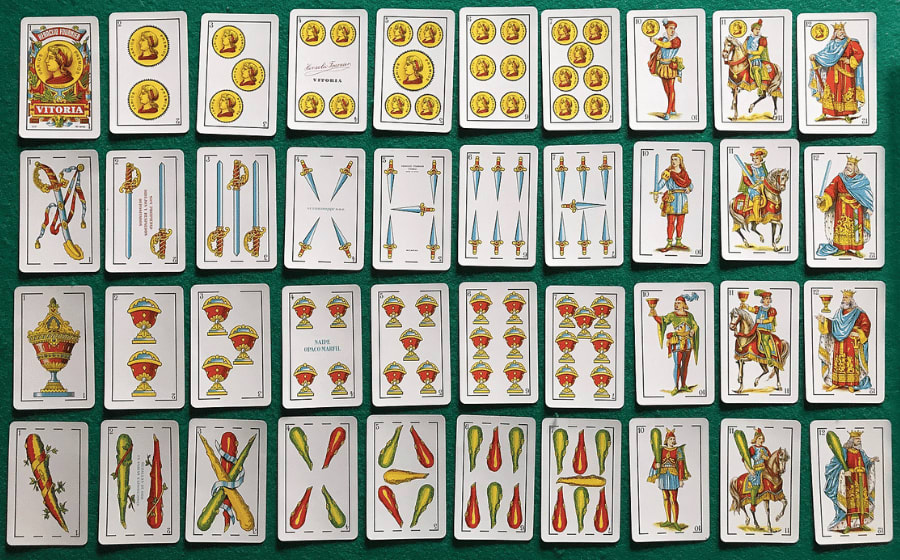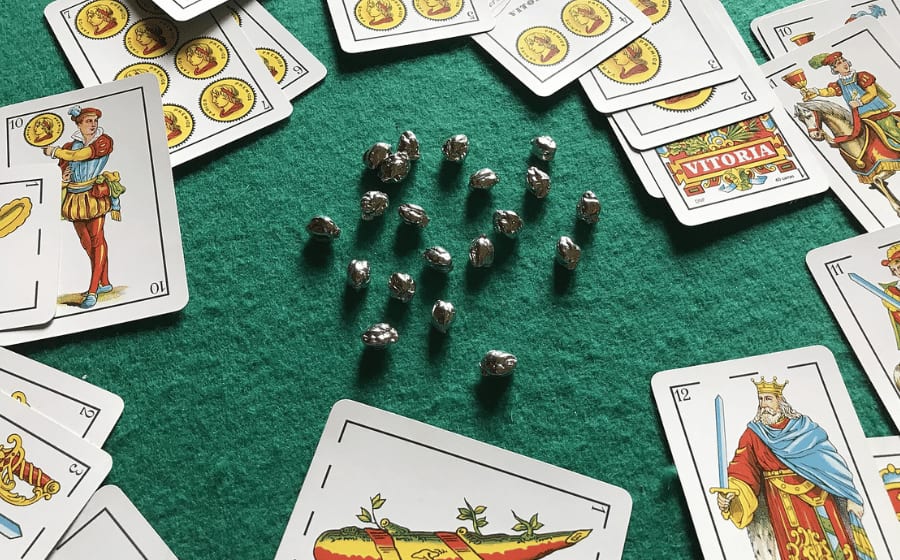How to Play Spanish Cards + 5 Traditional Games
December 21, 2022
Win a FREE Trip to Spain!
Exciting Announcement! For the first time, we're thrilled to offer exclusive trips to the heart of Spain - an experience like no other. This isn't your typical tourist journey; it's a unique opportunity to immerse yourself in authentic Spanish culture, alongside real locals and our passionate team.
But there's more! Simply by requesting information about this amazing trip, you'll be entered into a special draw to win a Fully Paid Trip to Spain for Two. And that's not all - everyone who inquires will receive an exclusive bonus gift, valued at $500, available only now.
Ready to Discover the Real Spain?Click Here ↑ to Request Information & Enter the Draw!
Did you know that there is a Spanish deck of cards? Many people do not know the Spanish deck of cards; most of them only know the French or English deck.
In Spain, card games are very popular! The Spanish deck of cards offers a great variety of games to entertain you and enjoy a fun afternoon. But, our deck of cards is a little different than the others, don’t let that worry you! You should just be concerned about whether you are skilled with the cards. 😜
In this post, I will explain to you what a deck of Spanish cards looks like and what each of them is called. I have also included a section with some of the best traditional Spanish card games to propose to your friends and family! Some simple and others a bit more complex. I’m sure you will have fun with all of them!
So if you’ve run out of ideas and don’t know how to fight boredom, don’t worry I got you covered!
Table of Contents ▼ ▶
What does a Spanish deck of cards look like?

The Spanish deck consists of a deck of 40 or 48 cards. The number of cards will depend on the game you will play.
The most commonly used version is the 40-card deck, numbered from 1 to 7 and 10 to 12 (known as the “figure cards”). The 10 is known as the “jack” (“sota” in Spanish), the 11 as the “horse” (“caballo”), and the 12 as the “king” (“rey”). There are no eights or nines in the 40-card deck.
The cards of the Spanish deck are divided into four suits (“palos” in Spanish) or “families,” which are “oros” “copas,” “espadas” and “bastos.” The English translation would be “coins,” “cups,” “swords,” and “clubs.” Each suit has ten or twelve cards (depending on whether the deck is a 40-card or 48-card deck) with different artistic images.
Depending on the game, the suits can be divided into “short” (“coins” and “cups”) and “long” (“swords” and “clubs”).
Some 48-card versions may include two jokers introduced from the French deck; in that case, the deck would be 50 cards.
The Spanish deck is used in Spain but has also spread to Latin America, Equatorial Guinea, and the Philippines.
Name of the cards in Spanish
| Card Number | Coins “Oros” | Cups “Copas” | Swords “Espadas” | Clubs “Bastos” |
|---|---|---|---|---|
| 1 | As de oros | As de copas | As de espadas | As de bastos |
| 2 | Dos de oros | Dos de copas | Dos de espadas | Dos de bastos |
| 3 | Tres de oros | Tres de copas | Tres de espadas | Tres de bastos |
| 4 | Cuatro de oros | Cuatro de copas | Cuatro de espadas | Cuatro de bastos |
| 5 | Cinco de oros | Cinco de copas | Cinco de espadas | Cinco de bastos |
| 6 | Seis de oros | Seis de copas | Seis de espadas | Seis de bastos |
| 7 | Siete de oros | Siete de copas | Siete de espadas | Siete de bastos |
| 8 | Ocho de oros | Ocho de copas | Ocho de espadas | Ocho de bastos |
| 9 | Nueve de oros | Nueve de copas | Nueve de espadas | Nueve de bastos |
| 10 | Sota de oros | Sota de copas | Sota de espadas | Sota de bastos |
| 11 | Caballo de oros | Caballo de copas | Caballo de espadas | Caballo de bastos |
| 12 | Rey de oros | Rey de copas | Rey de espadas | Rey de bastos |
5 Spanish card games and how to play them

Mus
Let me introduce you to the quintessential Spanish card game! This is one of the most popular games in Spain; even championships are organized! It is a game with more than two hundred years of history and whose origin is mostly accepted to be in the Basque Country.
It is also a trendy game in Latin American countries, such as Uruguay, Argentina, Chile, Colombia, Mexico, and some southern France regions.
The “Mus” uses a Spanish deck of 40 cards. The game is played in pairs (one pair plays against the other). The game aims to win eight “amarrakos” (40 stones) in one or more partial games. You can also play six “amarrakos” (30 stones).
The order of the cards, from highest to lowest, is as follows: king or three, knight, jack, seven, six, five, four, and two or ace. There is no trump or suit distinction.
The value of the cards in any of the four suits is as follows: each king, three, knight, or horse is worth 10 points; the other cards, their natural value represented by the index, except the deuces, which, like the aces, are worth one point. The kings have the same value as the threes, and the deuces have the same value as the aces, which is equivalent to playing with 8 kings and 8 aces. However, it can also be played with only 4 kings, and 4 aces, wherein the threes and deuces retain their natural value.
Players have to raise the bet, i.e., offering a certain number of points to be won in their turn. If they do not comply with the bet, they lose points. There are four different sets or betting opportunities:
- “Big” or “Grande”: consists of having cards as high as possible, according to their order. The more pairs or significant figures you have, the more chances of winning.
- “Small” or “Chica”: the inverse of “Grande,” which consists of holding cards as low as possible. The more pairs or small cards of lesser value you have, the more chances of winning.
- “Pairs” or “Pares”: when you have two or more identical cards. Pair “Par”: if you have only 2 cards that are the same. Half “Medias”: when you have 3 identical cards. “Duples”: consists of having 2 pairs.
- “Game” or “Juego”: a game is played when the sum of the value of the four cards of the hand is 31 or more, being the best game 31, followed by 32, and from this, it jumps to 40, descending to 37, 36, 35, 34 and 33, which is the worst. The winner is the one with the best game. If no player has “Game” that is, if the sum of the value of the four cards in each player’s hand is less than 31, the game is played to see who has the best point. The best point is 30 and goes down to 4, which is the worst.
The game is a bit complicated to explain, so the best thing to do is to put it into practice!
Chinchón
For this game, you will need two decks of Spanish cards.
Seven cards are dealt to each player, and one card is placed face up in the center of the table. The rest of the deck is placed next to that card face down so players can draw from there.
The game consists of making combinations of 3 and 4 cards with the same value (i.e., three 2, or four 3) or forming a straight. For example, you can make a straight with cards with the numbers 1, 2, and 3 but are of the same suit and have 4 fives. You can also have a complete straight with all 7 cards, known as a “chinchón.” If you make that combination, you win the game!
Cinquillo
This is one of the simplest Spanish card games and can be played by children and adults.
The number of players can go from 2 to 6 people.
The game aims to make ladders of the same suit, both ascending and descending. A straight will always start when a 5 is placed on the table. All the cards are dealt, and the person who has the “five of coins” (“Cinco de oros”) is the one who starts the game. If, when it is your turn, you cannot position any of the cards, you will have to take a turn.
The first player to run out of cards wins the game!
Siete y media
The objective of this game is to make seven and a half. There must be a banker who will be the one who deals with the cards. The dealer deals only one card per player. The player will ask for more cards or not, depending on the number he gets.
Each card has the value indicated by its number in the card, except for the jack, the horse, and the king, which are worth half a point.
The first player to get 7 and a half or the closest without going over will be the banker in the next round. In this game, you can bet with chips or coins! It is like a kind of Blackjack.
Tute
The objective of this game is to reach the maximum number of points previously agreed upon at the beginning of the game.
Eight cards are dealt among the players while the others are put aside, although they can be picked up during the game. Each player must show the last card he receives, which will be essential to winning.
Aces are worth 11 points, threes 10 points, kings 4 points, knights 3 points, and jacks 2 points.
If you have a knight and a king of the same suit, you can score 20 points by taking the trick or 40 points if they correspond to those of the showdown.
If you are a game fanatic like me and want to know 5 more card games, plus other typical games that are played in Spain; check out this article!
Where to buy a Spanish deck of cards
I know that now you are dying to play any of these 5 games, so here are the different options:
- Deck of 40 Spanish cards: The original one!
- Deck of 40 Spanish cards (x4): This will come in handy since you will need more than one deck in some games.
Spanish vocabulary for playing cards
To play these Spanish card games, you must learn some phrases and words. I’m sure they will be of great help to you!
Example Phrases:
What are the rules of the game?: "¿Cuáles son las reglas del juego?"
It’s your turn: “Es tu turno.”
You miss a turn: “Pierdes un turno.”
Shuffle and deal the cards: “Mezcla y reparte las cartas.”
It’s your turn to deal: “Te toca repartir.”
I need a card: “Necesito una carta.”
I don’t have cards, I pass: “No tengo cartas, paso.”
I can’t play, I’ll pass: “No puedo jugar, paso.”
Take a card from the deck: “Coge una carta del mazo.”
Have you ever played any of these games, or at least heard of any of them?
I hope that after reading this post, you will feel like playing some of the games I have shared with you; they are all super fun!









